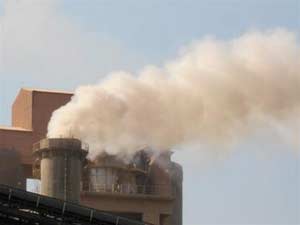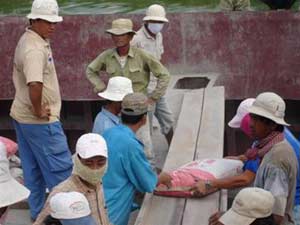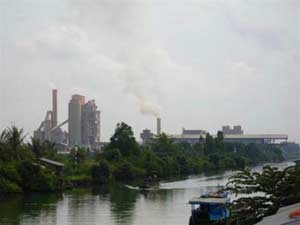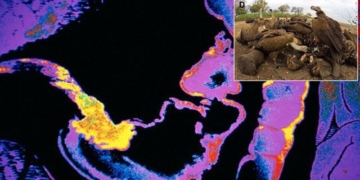Dust Accumulates Thickly on Rooftops, Affecting Meals and Drinking Water
 |
| Chimney of Ha Tien II Cement Plant (Photo: TTO) |
On certain days, dust clouds reduce visibility to just a few meters. The entire town has been living with cement dust for decades, with the risk of creating “lung disease villages” looming if nothing changes.
The town of Kien Luong is currently in the dry, hot season. The warm sea breeze mixes with the dust from the noisy operating cement plants, making the air stifling and hard to breathe. By noon, all the houses along the front in Lo Bom hamlet, Tam Thuc hamlet, and surrounding areas near the Ha Tien II Cement Plant are covered by tarps. Many households are spraying water outside, washing their homes, and some keep their doors tightly shut to eat.
Dusty Meals
Mr. Dao Kien and his wife reported that they have to clean their home at least five times a day; otherwise, dust settles thickly on the floors. “This season is better, but during the dry northerly winds and the east winds (three months before the Lunar New Year), the dust is everywhere. Even if we close all the doors during lunch and dinner, our meals are still dust-covered as dust pours in through the ventilation holes. The dust is terrible; outside, visibility is about five meters, and it’s hard on the eyes,” Kien said, pointing to the chimney that “billows smoke into the sky” from the Ha Tien II Cement Plant.
He added: “It’s because of that; day and night, it releases a thick haze of dust. We suffer too much living near the plant, inhaling dust all year round, plus the constant blasting noise day and night.” Ms. Pham Thi Thanh, who lives across the street, has installed double doors to combat dust. Dozens of households in the vicinity have set up tarps and mosquito nets.
 |
| Workers at risk of illness – according to doctors’ recommendations (Photo: TTO) |
As for coffee shops and eateries, they have to endure the dust too. Ms. H., the owner of a pho shop in Tam Thuc hamlet, lamented: “In a food business, we can’t cover up, set up tarps, or close the doors because no customers would come in. If we open to sell, we are inviting dust into the shop; on windy days, to protect customers, we have to continuously spray water and run the fans at full speed.
Yet even that can’t stop the dust; on days when it’s really bad, no one dares to come in for a meal.” Coffee shops located within the “dust zone” of the cement dust share the same fate. Many young people mentioned that drinking coffee here isn’t leisurely like elsewhere; they have to “quickly sip” their drinks to avoid dust.
The students from Kien Luong Primary School and Kien Luong Secondary School are also in the dust zone, located just 100 meters from the Ha Tien II Cement Plant. Teacher T. from Kien Luong Primary School said: “The first lesson we teach first graders here is how to cope with dust and live with it.”
While residents suffer, what about the workers directly employed in cement plants? Mr. Nguyen Minh T., a worker in the loading area of a cement plant for over 20 years, shared that nasal inflammation, sore throat, and many other ailments among workers are commonplace.
“Working directly with toxic cement dust without getting sick is unusual. Last month, I had a sore throat for a whole month, couldn’t speak, and spent a fortune on treatment that didn’t work. The doctor said my nasal inflammation and sore throat have become chronic, and I have to live with it as there’s no cure.”
Another worker, Nguyen Van H., from Ha Tien II Cement Plant, added that workers involved in loading and bagging suffer the most; often, after a shift, they are covered in dust, looking like they’ve rolled in flour!
The canals and coastal areas near the town are also severely polluted due to the dust and waste from the cement production cluster. According to a report from the Kien Giang People’s Committee: “… It raises the concentration of suspended solids in surface water in the surrounding areas, causing soil and water acidification during heavy rains. It destroys vegetation in mining areas, leading to a loss of water retention capacity for groundwater sources.
It causes erosion, creates ponds and lakes, and degrades the area’s aesthetics.” Residents report that rainwater here is unusable. Every heavy rain causes the town to be flooded with black water flowing into the canals and lakes, making residents afraid to bathe in them. Aquaculture near the cement plants has become nearly impossible.
The Rise of Lung Disease Villages…
 |
| The chimney of Ha Tien II Cement Plant emits thick smoke day and night (Photo: TTO) |
Kien Giang Province has five cement plants, all located in Kien Luong District, along with dozens of small lime kilns. The dust from the cement production cluster directly affects four communes and one town in Kien Luong District.
According to an environmental report from the Kien Giang People’s Committee in 2005, among the five operating cement plants, only the Holcim Cement Plant has a relatively adequate waste treatment system. The waste treatment systems in other plants do not meet standards.
Some plants are too old, with outdated lime kilns, stone crushing stations, and small factories that haven’t invested in waste treatment systems, contributing to pollution in surrounding residential areas. The two most polluting plants are the 82,000-ton cement plant and Ha Tien II Cement Plant. Ha Tien II has been placed on the Ministry of Natural Resources and Environment’s “blacklist” of polluting plants.
In an interview, Mr. Ly Thanh Hue – director of Ha Tien II Cement Plant – stated: “Our plant operates with two production lines from 1964 and 1971. These lines are too old, and the waste and emissions treatment systems are inefficient. Therefore, the environmental emissions from the plant do not meet expectations.” The condition of many other plants in the region is not better than that of Ha Tien II.
|
In discussions with reporters about the environmental pollution situation in the Kien Luong Industrial Zone, Mr. Le Huu Hung – deputy chairman of the Kien Giang People’s Committee – stated: “Indeed, the level of pollution is increasingly severe, affecting the daily lives of thousands of households in Kien Luong town. Residents have complained, and the provincial People’s Council has raised the issue several times. The leaders of the provincial party committee and the People’s Committee are very concerned and have demanded that cement plants implement measures to reduce pollution levels (cement dust) soon. However, the issue is not simple; companies in the industrial zone use outdated technology, so changing technology is necessary to reduce pollution levels, and doing so requires significant funding. To ensure the health of workers and residents, the province has requested companies to conduct regular health check-ups for their workers. For the residents, the province will instruct localities to facilitate timely health examinations and treatments for them.” |
According to Mr. Nguyen Van Thanh – deputy head of the Kien Luong Health Department, nearly 60,000 residents are directly inhaling cement dust, with one-third of the population enduring the noise from rock blasting and trucks transporting stone. According to an irregular assessment by the Kien Luong Health Department, up to 30% of children under five in the district suffer from pneumonia and mild respiratory infections. This rate is on the rise.
A 2005 survey from the Kien Giang Center for Labor Health and Environment indicates that almost all workers are affected by illnesses such as pneumonia, reduced vision, hearing loss, rhinitis, dental issues, and skin diseases, with high rates. Notably, dozens of workers are classified as having poor health, suffering from severe illnesses: pulmonary tuberculosis, chronic sore throat, and occupational deafness.
“If the factories do not implement measures to limit pollution levels, ‘lung disease villages’ will form in Kien Luong district in the near future,” said Mr. Thanh, expressing his concerns. “We have repeatedly recommended to higher authorities and advised the factories, but there has still been no reasonable solution.”
For many years, the Department of Natural Resources and Environment of the province has not released any environmental monitoring reports regarding the cement production industrial cluster in Kien Luong district. There are only brief annual reports from the provincial People’s Committee and one environmental monitoring report commissioned by the Ha Tien II Cement Plant itself. This lack of oversight poses a risk of developing “lung disease villages” in Kien Luong district.


















































